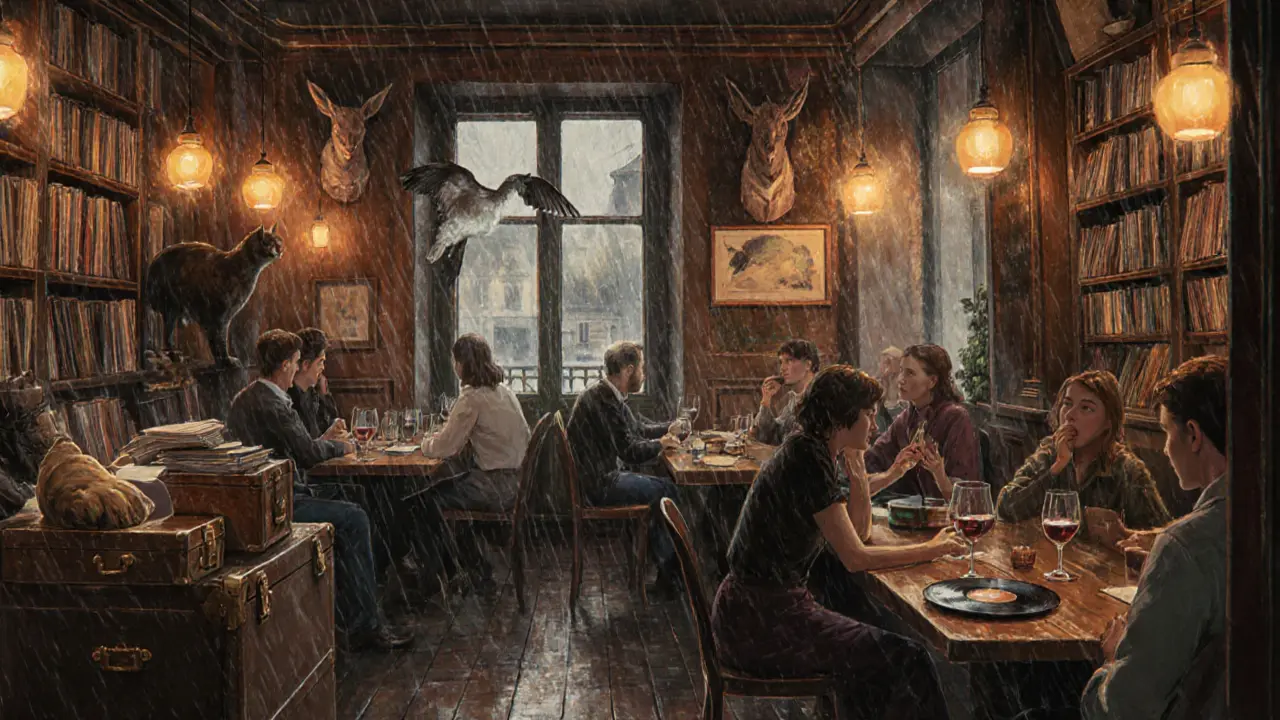Paris doesn’t sleep when the sun goes down-it transforms. The city’s nighttime energy isn’t just about drinking and dancing. It’s about jazz drifting from basement clubs in Saint-Germain, the quiet clink of wine glasses in hidden wine bars near Canal Saint-Martin, and the way the Seine reflects neon signs as midnight approaches. This isn’t the Paris of postcards. This is the Paris that locals know, the one that hums with history, art, and unexpected surprises after 10 p.m.
Where the Locals Go: Beyond the Tourist Hotspots
If you’ve only been to the Eiffel Tower at night or drunk champagne at a rooftop bar in La Défense, you’ve seen one version of Paris. The real nightlife lives in neighborhoods most tourists never wander into. In the 10th arrondissement, Bar Le Comptoir Général feels like a forgotten attic filled with vintage suitcases, taxidermy, and vinyl records spinning from a 1970s turntable. The crowd? Artists, students, expats, and Parisians who’ve been coming here since 2012. No cover charge. No dress code. Just good wine and a vibe that feels like you’ve stumbled into someone’s living room.
In the 11th, Le Baron still draws a mix of creatives and celebrities, but the real gem is La Belle Hortense, a tiny bar tucked behind a bookshop. The bartender, Marie, knows every regular’s drink before they sit down. She pours natural wines from small vineyards in the Loire Valley and plays French indie rock so softly you have to lean in to hear it. This isn’t a place to be seen. It’s a place to feel something.
The Jazz Underground: Where Paris Breathes Through Music
Paris has been a jazz capital since the 1920s, when Django Reinhardt played in smoky clubs while the city was still recovering from war. Today, that legacy lives on in places like Le Caveau de la Huchette in the Latin Quarter. The walls are stained with decades of smoke, the floor creaks under dancers, and the band plays swing and bebop with a rawness you won’t find in concert halls. Tourists line up here, but the regulars? They arrive after midnight, order a carafe of red, and dance like no one’s watching-because no one is.
For something more intimate, head to Le Sunset in Montmartre. It’s a basement bar with no sign, just a single red light above the door. Inside, a trio plays standards with a modern twist-think Miles Davis meets Daft Punk. The owner, a retired saxophonist named Jean-Pierre, still plays on Tuesdays. He doesn’t advertise it. He doesn’t need to. The word spreads through whispers.
Wine Bars and Natural Wines: Paris’s Quiet Revolution
Paris used to be a city of beer halls and cocktails. Now, it’s leading Europe’s natural wine movement. These aren’t the big-name Bordeaux or Burgundies you see in supermarkets. These are wines made by small growers who avoid chemicals, use wild yeast, and bottle without filtration. The result? Wines that taste alive-earthy, funky, bright.
Le Verre Volé in the 10th arrondissement has been a pioneer since 2008. Their list changes weekly, based on what’s arriving from small producers in Alsace, Jura, and even Corsica. The staff doesn’t push expensive bottles. They ask what you ate for dinner, then recommend something that matches. One regular told me he’s tried 300 different wines here in five years. He’s never paid more than €12 a glass.
Across town, Le Bistrot du Peintre in the 18th arrondissement serves wine by the carafe alongside simple dishes: charcuterie, goat cheese, crusty bread. The lights are low, the music is French chanson, and the owner, a former painter, still hangs his own artwork on the walls. It’s not a bar. It’s a living room with wine.

Club Culture: From Industrial Warehouses to Hidden Speakeasies
Parisian clubs don’t open at midnight. They open at 2 a.m. And they don’t close until the sun comes up. The scene is scattered, underground, and fiercely local. La Machine du Moulin Rouge isn’t the cabaret you think of-it’s a converted factory in the 13th where techno and house DJs play to crowds of 500, all dancing under strobes that mimic the glow of the Seine at night.
For something more experimental, try Le Très Club in the 19th. It’s inside an old schoolhouse. The walls are painted black, the sound system was built by a local engineer, and the DJs play everything from Moroccan gnawa to Berlin minimal. You won’t find a VIP section. No bottle service. Just people who came because they love the music, not the label.
And then there’s Le Perchoir-a rooftop bar with a secret staircase behind a bookshelf. You need a password. You get it by texting a friend who’s been before. The view of the Eiffel Tower is breathtaking, but the real draw is the crowd: poets, filmmakers, and musicians who come to talk, not to be seen.
Midnight Snacks and Late-Night Eats
Parisians don’t eat dinner at 8 p.m. and then go home. They eat at 10 p.m., then go out, then eat again at 2 a.m. The city’s late-night food scene is as rich as its bar culture.
Le Comptoir du Relais in Saint-Germain stays open until 3 a.m. Their duck confit sandwich is legendary. So is the wine list-€8 glasses, all by the glass. La Belle Équipe in the 11th serves fried chicken and natural wine until 4 a.m. on weekends. You order at the counter, sit on wooden benches, and eat with your hands. No forks. No napkins. Just good food and loud laughter.
And then there’s the baguette. Not the kind you buy in the morning. The kind you get at Boulangerie Pichard at 2 a.m. on weekends. The baker, Michel, has been kneading dough since he was 16. He puts butter in the dough, not margarine. He lets it rise for 24 hours. The crust cracks like glass. The inside is soft, warm, and smells like childhood. You eat it standing up, still in your night clothes, and you don’t care who sees you.

What to Wear, When to Go, and What to Avoid
You don’t need a suit to get into a Parisian bar. But you do need to look like you care. No flip-flops. No baseball caps. No shorts after 9 p.m. Parisians dress with intention-even if it’s just jeans and a well-fitting jacket. It’s not about being fancy. It’s about being present.
Don’t expect to walk into a club at 10 p.m. and find a party. Most places don’t fill up until after midnight. The best time to arrive? Between 1 a.m. and 2 a.m. That’s when the real crowd shows up-the ones who’ve been out since dinner, who’ve had a few glasses of wine, who aren’t trying to impress anyone.
Avoid the bars near the Champs-Élysées after 11 p.m. They’re overpriced, overcrowded, and filled with tourists who’ve been told “Paris nightlife” means glitter and loud music. The real scene is quieter, deeper, and hidden in plain sight.
Paris After Dark Isn’t Just a Night Out-It’s a Ritual
Parisian nightlife isn’t about partying. It’s about connection. It’s about the way strangers become friends over a shared bottle of wine. It’s about the jazz musician who plays one more song because someone clapped too hard. It’s about the baker who lets you have a warm baguette even though it’s not for sale.
When you leave a Parisian bar at 4 a.m., you don’t just go home. You walk slowly. You smell the damp air off the Seine. You hear the distant sound of a train rolling past. And for a moment, you understand why this city never sleeps. It’s not because it’s loud. It’s because it’s alive.
Is Paris nightlife safe at night?
Yes, most areas popular with nightlife-like Le Marais, Saint-Germain, Montmartre, and Canal Saint-Martin-are well-lit and patrolled. Stick to main streets after midnight, avoid isolated alleys, and keep your belongings close. Like any big city, petty theft happens, but violent incidents are rare. Locals often walk home alone after midnight without issue.
Do I need to make reservations for bars or clubs in Paris?
Most small bars and jazz clubs don’t take reservations. You just show up. Some popular spots like Le Baron or Le Perchoir might have a wait on weekends, but it’s rarely more than 15 minutes. For larger clubs like La Machine du Moulin Rouge, you might need to buy tickets online in advance, especially if there’s a special guest DJ.
What’s the average cost of a night out in Paris?
You can have a full night out for €30-€50. A glass of natural wine costs €8-€12, a beer is €6-€9, and a late-night snack like a sandwich or fried chicken is €10-€15. Clubs usually charge €10-€15 at the door, but many jazz bars and wine spots have no cover. Skip the tourist traps near the Eiffel Tower-prices there can double.
Are there any quiet or intimate nightlife options in Paris?
Absolutely. Places like Le Verre Volé, La Belle Hortense, and Le Bistrot du Peintre are perfect for quiet evenings. They’re small, dimly lit, and focused on conversation. Many have live acoustic music or curated playlists-not loud enough to drown out talk. If you want to hear someone’s story, not a DJ’s beat, these are your spots.
What’s the best time to experience Paris nightlife?
The magic happens between midnight and 3 a.m. That’s when the real crowd arrives-locals, artists, musicians, and people who’ve had dinner and are now ready to unwind. Bars get lively after 1 a.m., clubs hit their stride after 2 a.m., and the best food spots are busiest after 2 a.m. Arrive too early, and you’ll be sitting alone. Arrive too late, and you might miss the energy.
Can I find English-speaking staff in Paris nightlife spots?
In tourist-heavy areas, yes. But in the real gems-like Le Verre Volé, Le Caveau de la Huchette, or La Belle Hortense-you’ll often find staff who speak little or no English. That’s part of the charm. Learn a few basic French phrases: "Un verre de vin, s’il vous plaît," "Merci," "Ça va?" A smile goes a long way. Most people appreciate the effort.

